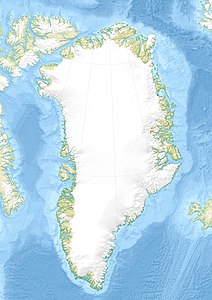Ketil
| Ketil | ||
|---|---|---|
|
The west wall of the Ketil |
||
| height | 2010 m | |
| location | Klosterdalen, Tasermiutfjord, South Greenland | |
| Coordinates | 60 ° 25 ′ 0 ″ N , 44 ° 31 ′ 0 ″ W | |
|
|
||
| rock | granite | |
| First ascent | 1974 | |
The Ketil or Uiluit Qaqqaa is a 2010 m , according to other information 2003 m high mountain in the south of Greenland .
The Ketil is located on the east bank of the Tasermiut fjord in the municipality of Nanortalik , about four kilometers north of the Ulamertorsuaq . Smaller firn fields can be found southwest, southeast and east of the mountain , the Ketil itself has no glaciation due to its steep rock walls . The Klosterdalen ( Danish : Klostertal) runs north of the mountain in an east-west direction . This valley takes its name from the former Augustinian monastery at Tasermiutsiaat at the mouth of the Klosterdalen in the Tasermiutfjord, which was built here by Nordic settlers in the 13th century . The Nordic name of Ketil, which was named after one of the settlers, also comes from this time. Only ruins remain of the monastery, located about four kilometers north-north-west of the Ketil. The rich mussel beds that can be found here in the fjord explain the Greenlandic name of the mountain, Uiluit Qaqqaa , which means “shell mountain ”. Occasionally this name is also used for the whole of Klosterdalen.
The Ketil is valued by climbers because of its solid granite rock. In 1974 a rope team from Lienz climbed it for the first time, with the route ( UIAA V-VI ) leading over the north-west to the south face. Today the south face is not climbed as often, but there are three different routes with difficulties up to 7a A1 . Today the west wall, between 1200 and 1450 meters high, is considered to be a particularly challenging big wall and is now accessible through four routes with difficulties up to 5.12 on the American scale. It is possible, however, that there are more climbed lines than documented, as some climbers demand that exact route descriptions in the granite mountains of South Greenland should be dispensed with in order to enable them to continue to independently discover their own routes. However, the east and north faces of the Ketil are probably not yet climbed as they are less attractive because of dangerous snow fields and heavy lichen growth.
The two secondary peaks of the Ketil, Pyramid and Pingasut , are also popular climbing destinations.
swell
- ^ Jacques Borlée: Ketil, West Face, South West Greenland, 1984 . In: American Alpine Club (Ed.): American Alpine Journal . 1986, ISSN 0065-6925 , pp. 185-186 .
- ↑ Greenland Tourism: Hiking Map South Greenland / Tasermiut fjords - Nanortalik . 1996.
- ↑ Lindsay Griffin: Tasermiut Fjord, Ulamertorsuaq and Ketil, first ascents . In: American Alpine Club (Ed.): American Alpine Journal . 2005, ISSN 0065-6925 , p. 249-250 .
- ↑ Doug Byerly: Ketil, West Face . In: American Alpine Club (Ed.): American Alpine Journal . 2000, ISSN 0065-6925 , p. 243-245 .
- ↑ Michael Hjorth: Ketil Fjeld, South Greenland, 1987. bigwall.dk, accessed on March 24, 2008 (English).
- ↑ Bernard Amy: Apostle's Tommelfinger, Suikarsuak, South Greenland . In: American Alpine Club (Ed.): American Alpine Journal . 1977, ISSN 0065-6925 , p. 205-206 .

